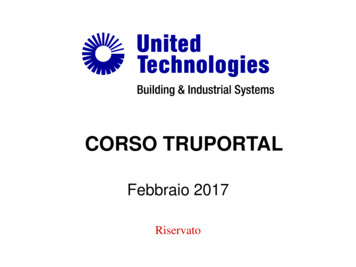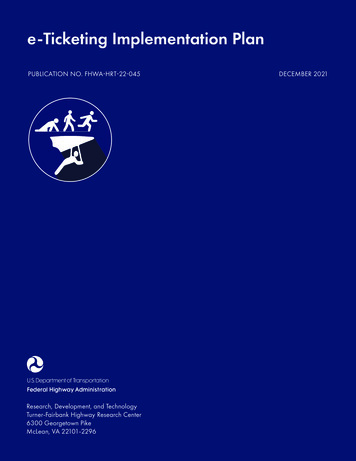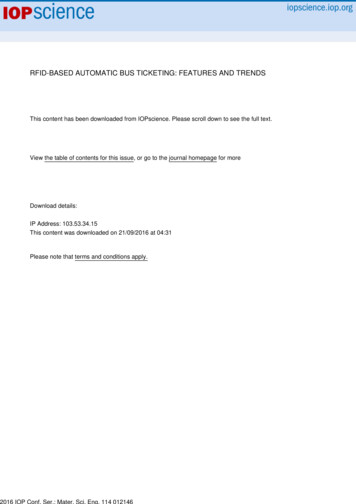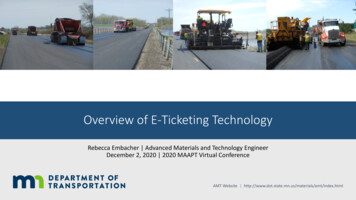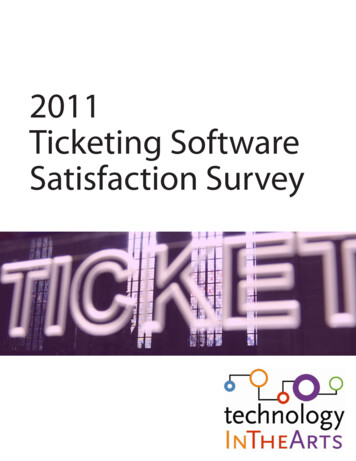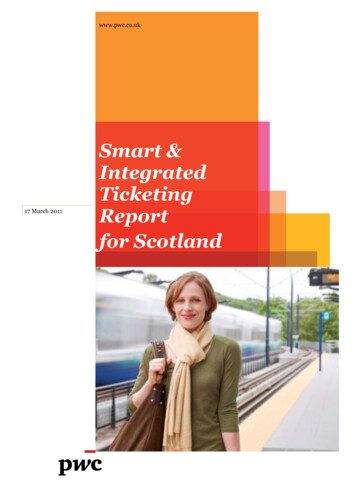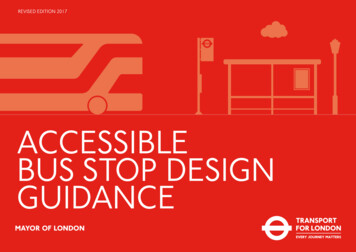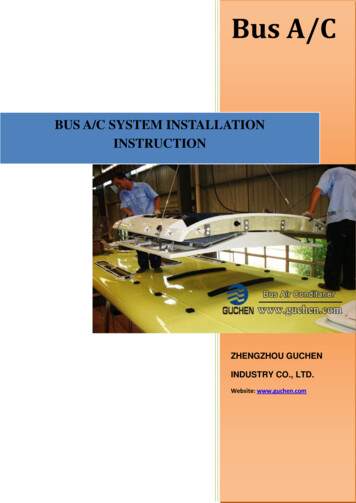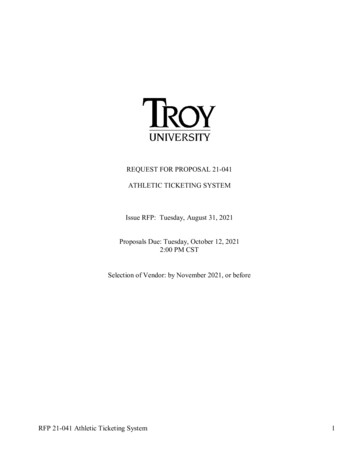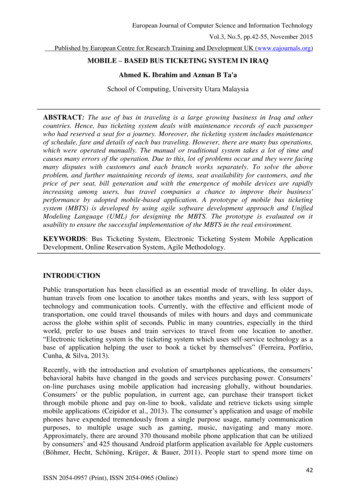
Transcription
European Journal of Computer Science and Information TechnologyVol.3, No.5, pp.42-55, November 2015Published by European Centre for Research Training and Development UK (www.eajournals.org)MOBILE – BASED BUS TICKETING SYSTEM IN IRAQAhmed K. Ibrahim and Azman B Ta'aSchool of Computing, University Utara MalaysiaABSTRACT: The use of bus in traveling is a large growing business in Iraq and othercountries. Hence, bus ticketing system deals with maintenance records of each passengerwho had reserved a seat for a journey. Moreover, the ticketing system includes maintenanceof schedule, fare and details of each bus traveling. However, there are many bus operations,which were operated manually. The manual or traditional system takes a lot of time andcauses many errors of the operation. Due to this, lot of problems occur and they were facingmany disputes with customers and each branch works separately. To solve the aboveproblem, and further maintaining records of items, seat availability for customers, and theprice of per seat, bill generation and with the emergence of mobile devices are rapidlyincreasing among users, bus travel companies a chance to improve their business'performance by adopted mobile-based application. A prototype of mobile bus ticketingsystem (MBTS) is developed by using agile software development approach and UnifiedModeling Language (UML) for designing the MBTS. The prototype is evaluated on itusability to ensure the successful implementation of the MBTS in the real environment.KEYWORDS: Bus Ticketing System, Electronic Ticketing System Mobile ApplicationDevelopment, Online Reservation System, Agile Methodology.INTRODUCTIONPublic transportation has been classified as an essential mode of travelling. In older days,human travels from one location to another takes months and years, with less support oftechnology and communication tools. Currently, with the effective and efficient mode oftransportation, one could travel thousands of miles with hours and days and communicateacross the globe within split of seconds. Public in many countries, especially in the thirdworld, prefer to use buses and train services to travel from one location to another.“Electronic ticketing system is the ticketing system which uses self-service technology as abase of application helping the user to book a ticket by themselves” (Ferreira, Porfírio,Cunha, & Silva, 2013).Recently, with the introduction and evolution of smartphones applications, the consumers’behavioral habits have changed in the goods and services purchasing power. Consumers’on-line purchases using mobile application had increasing globally, without boundaries.Consumers’ or the public population, in current age, can purchase their transport ticketthrough mobile phone and pay on-line to book, validate and retrieve tickets using simplemobile applications (Ceipidor et al., 2013). The consumer’s application and usage of mobilephones have expended tremendously from a single purpose usage, namely communicationpurposes, to multiple usage such as gaming, music, navigating and many more.Approximately, there are around 370 thousand mobile phone application that can be utilizedby consumers’ and 425 thousand Android platform application available for Apple customers(Böhmer, Hecht, Schöning, Krüger, & Bauer, 2011). People start to spend more time on42ISSN 2054-0957 (Print), ISSN 2054-0965 (Online)
European Journal of Computer Science and Information TechnologyVol.3, No.5, pp.42-55, November 2015Published by European Centre for Research Training and Development UK (www.eajournals.org)mobile devices than desktop and laptops (Meeker, 2015). Indeed, mobile devices (e.g.,smartphone and tablet PC) are increasingly becoming an essential part of Iraqis' as the mosteffective and convenient communication tools not bounded by time and place (Jarad, 2014).Many people in Iraq do not carry their PC outside the office, but mobile phones are with themat all time. Nowdays, mobile phones and smartphones become very popular for a largenumber of users (Ketmaneechairat, 2014). Using a mobile phone for making reservationsystems is the easiest and convenient way to perform this task. The online booking, ingeneral, gives the customer extra information regarding the company, availability of theservices, ticketing structure, prices, online payment and booking structure and other servicesrendered. Besides that, in certain company, handheld mobile communication may bringsimilar better closer partnerships between a company and its customers (Paper, 2012).The ProblemAll public transportation modes in Iraq, except air transportation still use the traditional ticketsystem, which use a paper based ticket. The problem with the traditional ticket bus system(manual ticket) is when users have to stand up in a long queue to buy a bus ticket or askinginformation for buses schedule (Al-hijaj, Jabbar, & Kh, 2013). The main issue with manualsystem is each branch work separately, communication must be made by each branch’sfront-officer to the head office for each customer’s enquiry in order to get the latest update onschedule, seat availability and other reservation-related information; as well as to avoidduplicate bookings or over-capacity (Alaya, 2014). Moreover, there is also a physical limit tothe reservation availability as each branch only operates during certain hours and reservationscan only be made on-the-spot. These limitations are not the only issues the company iscurrently facing. In addition, that create problems include human errors (e.g. miscalculationsin ticket price, mistakes in noting passenger data, etc.). Furthermore, manual booking systemthe paper works can be easily lost the storage space and costs (Lu, 2007).According to survey by Al-hijaj et al., (2013), travelers at the Garage Baghdad bus station inBasra city in Iraq shows an average 97 % of passengers are not happy with the transportationsystem. Besides that, the result presents the registration operation in the Iraqi garage stationsthe majority of drivers suffer with their work. Therefore, a practical and workable of systemis required to overcome this problem.A mobile bus ticketing system (MBTS) can help and solve these kinds of problems. By usingthis system will help the company employees (e.g. Admins or drivers) in daily work bymaking their work more arranged and more connected to other company branches. Besidesthat, MBTS will be easier for employees to control and check the operations of the company.However, customers just from their mobile phone will be allowed to check for ticketavailability anytime and anywhere. Furthermore, the system will reduce the customer's fear oflosing a physical ticket, and allows vendors to significantly reduce ticket queues (Eicher, Nh,Eicher, & Us, 2012). Indeed, there are many similar systems in the different countries, but theoperation of the system in Iraq is different due to the transportation system environment andgeographical structure.43ISSN 2054-0957 (Print), ISSN 2054-0965 (Online)
European Journal of Computer Science and Information TechnologyVol.3, No.5, pp.42-55, November 2015Published by European Centre for Research Training and Development UK (www.eajournals.org)LITERATURE REVIEWTourism has demonstrated as one of the most successful sector in optimizing the mobileapplication. According to Buell, Campbell, & Frei, (2010) about 50% of existing tourismrecommender systems is designed for mobile devices. The Mobile application groupingaccessible in the tourism industry as mentioned, there are four main mobile travel applicationcategories “Online Booking”, Information Resource”, “Location Based Services”, and “TripJournals”. The “Online Bookings” category (Smirnov, Kashevnik, Shilov, Teslya, &Shabaev, 2014). These applications allow a tourist to make online reservations for differentservices (e.g., Bus travel, car rental, hotel, airplane ticket booking). Usually the touristsdemand applications from this category before the trip. According to (Gunduz & Pathan,2013), online purchases of flight tickets represented 32 percent of overall online purchasebusiness, Hotel and Tours represent 26 percent and event management tickets sold represent20 percent of global online purchases. Approximately 79 percent of United State mobilephone uses the device for online shopping convinces and needs.Consumers depend on their applications for more commercial dealings, social correspondingand community interaction. Results derived from these surveys show that airline, bus linersand travel agents, being the goods and service provider, should expand the ticketing servicesthrough mobile shopping. In addition, when the customer deliver the service independentlythrough the use of technology will simplify and increase efficiency of service delivery, thistechnology called self-service technology (SST). Self-service technology replacing thetraditional service encounter which in the process, there is a communication betweencustomer and employee become the customer deliver the service by themselves (Wang,Harris, & Patterson, 2012). Moreover, the customer unnecessary to visit a firm office to askabout banking transaction, tickets information and bill payment, through this service firmsgive simplicity for the customer to fulfill their needs, and customer can reduce money, time,and effort to fulfill their needs.Second purpose of providing self-service technologies is transacted, this technology enablesthe customer to make a transaction buy, pay, or order stuff from the internet without directinteraction with an employee. The third purpose of self-service technologies is to self-help.Through these SSTs, enable the customer to learn, receive information, train them, andprovide their own service. Furthermore, Self-service technologies indeed have a benefit forboth companies and consumer. SSTs are cost effective to escalation the benefit ofaccessibility, pervasive obtainability, and time and money savings and reduce anxiety.Nowadays electronic ticketing systems (e-ticket system) are particularly famous for thetraveler in the whole of the world. Electronic ticketing system is shift traditional ticketingsystem because a lot of advantages which customer can get from e-ticketing system forexample avoid queuing in ticket box. Electronic ticketing system begins in accordance withthe development of the internet, before electronic ticketing system begins there is severalticketing system which use paper based or smart card based. All kinds of ticketing systemhave the advantage and disadvantage, and already classify the advantage and disadvantage ofseveral kinds of ticketing system in the Table 1. (Jakubauskas, 2010):44ISSN 2054-0957 (Print), ISSN 2054-0965 (Online)
European Journal of Computer Science and Information TechnologyVol.3, No.5, pp.42-55, November 2015Published by European Centre for Research Training and Development UK (www.eajournals.org)Table 1: Type of TicketType of ticketPaper ticketsAdvantageDisadvantageCheap to produce.Weak protection.Easy to use.Risk of falsification.Not multifunctional.Not effective for undergroundurban transport.Paperdaily,weekly, Simple, easy to makemonthly, quarterly, nswithmagnetic strip single useand passesBetter protected than Need for contact.those made of paper, Risk of dis functioning ormore durable.failure on readers, magneticVery thick and light.strip becomes vulnerable tostronger crease or othercontact.Smart CardsVery convenientvalidating.Expensive to introduce.Gives data of passengerRisksoffakecards-ticket still exist.smartUseful for optimizationof routes according datareceived.Transaction time of contactsmart cards is longer thanthose of contactless dataVery multifunctionalapplication of smartcards.Electronic TicketNo cash payment.(E-ticket): e.g. SMS ticket, Safe payment.WAP page ticket.Convenient use.System should be wellorganized and maintained.Expensive to introduce.Lots of specific perators.The existence of e-ticketing system can reduce time to purchase the ticket and increases theconvenience of travellers, because a customer can buy the ticket anywhere and anytimewithout time limitation and limitation of place. Beside the advantage of customer, e-ticketingsystem also gives an advantage for service provider or public transport authority inmonitoring the actual traveler’s behavior. Electronic ticketing system which famous fortravelling in urban transportation are divided in to two kinds of e-ticketing system,mobile-ticketing system and internet ticketing system.45ISSN 2054-0957 (Print), ISSN 2054-0965 (Online)
European Journal of Computer Science and Information TechnologyVol.3, No.5, pp.42-55, November 2015Published by European Centre for Research Training and Development UK (www.eajournals.org)Mobile Ticketing (M-Ticketing)Mobile ticketing (m-ticketing) can be broadly defined as ordering, purchasing, delivery andusage of a product or service using mobile technology such as Wireless Application Protocol(WAP) (Skarica, Belani, & Illes, 2009). The mobile ticketing industry is a relatively recentand up-and-coming portion of the fast-growing e-commerce industry. According to someestimates, approximately 400 million mobile subscribers global networking system will usetheir mobile phones for ticketing by 2013, with total gross mobile ticketing transactionsreaching 92 billion by 2013 (Eicher et al., 2012). The mobile ticketing predictions are beingthe research domain for several years.M-ticketing permits a customer to purchase a valid and legitimate ticket through mobilephone application. The value added services provided by the application allows users of themobile ticket to store digital tickets on the phone. By doing so, the consumer is less likely tolose his ticket, eco-friendly, durable, cost effective and paperless. Generally, the mobileticketing process can be defined in the following steps (Ceipidor et al., 2013): Registration: Online ticketing requires a company to register with all the business andservices information. Provisioning: Allow mobile phone application to interact with customers, allowingthe purchase to take place. Validation: Validating and legitimate the ticket via electronic validation systembetween the company and the customer. Ticket check: Controller to verify and accept the sales and display of the mobile ticketas a valid ticket for the passenger, according to the terms displayed on the ticket.Indeed, mobile bus ticketing system (MBTS) is the most noteworthy prospects in Iraq toreduce expenditures and increase traveler's accessibility. This project will reduce ticketprocessing flow, reduce usage of paper and allows greater convinces and flexibility to thetraveler in Iraq cities and allow travel agent to make alterations to the journey. There areother important issues from the use of this technique such as the mobile ticket cannot be lostor stolen on the contrary of sending the ticket by mail also there is a probably of sending it tothe wrong address. MBTS will make customers' lives easier, and can get the service byhimself in anytime, anywhere and any devices.The Proposed SystemMobile Bus Ticketing System (MBTS) will have four actors who will interact withapplication. Firstly, passengers who will book the ticket, application will allow passenger toaccess, search and check bus ticket availability over the internet 24 hours a day, 7 days aweek in them mobile after install the application. In addition passengers can book the busticket. Secondly, Admin who will control and check whole the system, admin canadd/edit/delete bus, route, destination and so on. However, admin can distribute accounts forthe driver to allow them access to the system and for the guards as well. Thirdly, driver whowill drive the bus, his privilege less than the admin. Driver can only check his trip, the busnumber that it will ride it, beside that he can see the passenger's lists for a specific trip.Lastly, guard his privilege same with the driver only check the trips and see the passenger'slists. However, the MBTS prototype will work for smartphone for Android platform.46ISSN 2054-0957 (Print), ISSN 2054-0965 (Online)
European Journal of Computer Science and Information TechnologyVol.3, No.5, pp.42-55, November 2015Published by European Centre for Research Training and Development UK (www.eajournals.org)METHODOLOGYThe aim from this project is to develop a prototype mobile bus ticketing system (MBTS). Inorder to design and develop mobile application for the ticketing bus system, and to ensure thesuccess of the mobile application of the ticketing bus system. This project is divided intothree main phases of planning and execution as shown in figure 1PHASESACTIVITIESRESULTS1.Studyandidentify the problemof ticketing systemConduct the literaturereview that related tothe ticketing systemProblemdefinitionandunderstanding the project aswell.2.Developaprototype of MBTSRequirement, analysis,design, develop andtest the prototype.Prototype of Mobile busticketing system (MBTS)developed.ACHIEVE OBJECTIVEONEACHIEVE OBJECTIVETWO3. Evaluation of theMBTS prototypeEvaluate theprototypeMBTSPrototype of Mobile busticketing system (MBTS)evaluatedACHIEVE OBJECTIVETHREEFigure 1: Flowchart of Research ActivitiesPhase one: Study and identify the problemFirst phase focused on how to understand the objectives and give a clear definition of theproblem of ticketing system in order to create MBTS applications. The outcome for thisphrase is the project awareness of problem which gives the clear and full view about thedetail problem, especially in a manual system.Phase two: Develop a MBTS prototypeSecond phase aims to develop the MBTS prototype through identifying the requirement,analyze, design, develop and test the prototype, agile will use as a method. The outcome ofthis step is gathering the requirements, design the entity relationship diagram (ERD) fordatabase and analysis the system using unified modeling language (UML) as well as todevelop the prototype of MBTS. The step for system developments of this system asfollowing:Requirements gatheringThe task started with requirement collecting to develop bus reservation prototype Table 1 and2 shows the result below which is the functional requirements and non-functionalrequirement of the system. In the priority column, the following short hands are used: M: mandatory requirements (something the system must do).47ISSN 2054-0957 (Print), ISSN 2054-0965 (Online)
European Journal of Computer Science and Information TechnologyVol.3, No.5, pp.42-55, November 2015Published by European Centre for Research Training and Development UK (www.eajournals.org) D: desirable requirements (something the system preferably should do). O: optional requirement.Table 2: MBTS Non-functional requirementsFunctional RequirementsRequirementRequirement DescriptionPriority#IDMBTS 1Explore system1MBTS 1 1User can search about ticket availability by selectingMdate, and from where to where.2MBTS 1 2The User must fill all the information fields beforeMpress book button, otherwise the system will show anerror message.MBTS 2Login to the system3MBTS 2 1User must enter his valid username and password toMaccess to the system, otherwise the system will show anerror message.MBTS 3Manage Timetable4MBTS 3 1Admin can create a new timetable (include all the tripMdetails)5MBTS 3 2Admin can manage (update, edit and delete) timetableM7MBTS 3 3User can check the timetable scheduleMMBTS 4Edit Bus8MBTS 4 1Admin can create a new bus (include all the bus details)M9MBTS 4 2Admin can manage (update, edit and delete) busesMMBTS 5Edit Route10 MBTS 5 1Admin can create a new route (include all the routeMdetails)11 MBTS 5 2Admin can manage (update, edit and delete) routesMMBTS 6Edit Station12 MBTS 6 1Admin can create a new station (include all the stationdetails)13 MBTS 6 2Admin can manage (update, edit and delete) stationsMBTS 7Edit Garage14 MBTS 7 1Admin can create a new garage (include all the garageMdetails)15 MBTS 7 2Admin can manage (update, edit and delete) garagesMMBTS 8Edit Staff16 MBTS 8 1Admin can create a new staff (include all the staffMdetails)17 MBTS 8 2Admin can manage (update, edit and delete) staffsMMBTS 9Manage Profile18 MBTS 9 1User can update username and passwordMNon-functional RequirementsMBTS 1Usability48ISSN 2054-0957 (Print), ISSN 2054-0965 (Online)
European Journal of Computer Science and Information TechnologyVol.3, No.5, pp.42-55, November 2015Published by European Centre for Research Training and Development UK (www.eajournals.org)1234MBTS 1 1MBTS 1 2MBTS 1 3MBTS 2MBTS 2 15MBTS 2 26MBTS 3MBTS 3 179MBTS 4MBTS 4 1MBTS 5MBTS 5 1The system should be user friendly and efficientlyThe system must be easy and understandableThe system should be expandableReliabilitySystem should be able to perform its required functionsunder stated conditions for specific period of time.The system should stay working smoothly without anyinterruptionSecurityOnly Admin will be able to log in to the system tomake maintenanceAvailabilityThe system should have high up time.PerformanceThe system must have a high speed of manipulationdata and reply to the user requests.MMMMMMMMSoftware Advanced Analysis TechniquesIn this study we highlight the use of UML to design MBTS prototype. We design bothsequence diagrams which is used to show the dynamic behavior of application design and usecase diagram as well. The sequence diagram present interactions between the objects thatarranged in a time sequence.A) Use-Case DiagramUse case diagram in UML used to represent functional requirements, however, is familiarmodel artefact helping for specify the requirements of computer based systems in the earlyphase of development. Figure 2 which describe the main overall interaction between MBTSand (Passenger, Admin, Driver and Guard), as showing in figure.B) Sequence DiagramA sequence diagram is a kind of interaction diagram that shows how processes operate withone another and in what order. It is a construct of a Message Sequence. Figure 3 illustrate theinteraction process between the user and the system in order to book ticket.49ISSN 2054-0957 (Print), ISSN 2054-0965 (Online)
European Journal of Computer Science and Information TechnologyVol.3, No.5, pp.42-55, November 2015Published by European Centre for Research Training and Development UK (www.eajournals.org)Figure 2: Use-Case of MBTSFigure 3: Sequence Diagram for user bookingClass DiagramERD is a kind of graph for presenting visually the entity set, attribute and the relationshipsbetween entities in a database. ERD is top down approach to database design that begins byidentifying the important data called entities and relationships between the data that must berepresented in the model. We design ERD if figure 4 of MBTS by using the technique of50ISSN 2054-0957 (Print), ISSN 2054-0965 (Online)
European Journal of Computer Science and Information TechnologyVol.3, No.5, pp.42-55, November 2015Published by European Centre for Research Training and Development UK (www.eajournals.org)normalization. Normalization is formal technique of analyzing base on their primary key. Atthe end of ERD design we validate and check the model to ensure it is capable to support therequired transaction given in the user requirement specification.Figure 4: Class Diagram of MBTSSystem DevelopmentSystem development is implementation of the MBTS prototype. The prototype has beendeveloped by using Phonegap framework to work in different OS (Operating System) (e.g.IOS, Android, Windows phone). In addition, JavaScript, jQuery mobile, HTML5, and CSS3on mobile side also will be applied. Besides that, MySQL Database and PHP on the serverside with RESTful will be used to serve a mobile application request. System meets all thefunctional requirements which have been collected in the requirement gathering step. Figure5a-5c shown the MBTS interfaces:Figure 5a: MBTS InterfaceFigure 5b: Booking PageFigure 5c: Admin Dashboard51ISSN 2054-0957 (Print), ISSN 2054-0965 (Online)
European Journal of Computer Science and Information TechnologyVol.3, No.5, pp.42-55, November 2015Published by European Centre for Research Training and Development UK (www.eajournals.org)Figure 5a shown the first page for MBTS application when the user open the application,figure 5b shown the booking page for user in order to do booking and figure 5c shown thedashboard for Admin.Phase three: Evaluation of the MBTS prototypeThis part explains the analysis of the evaluation that has been done for MBTS prototype.After the prototype development is finalized, The System has been tested by the actual usersand through Usability Questionnaire adopted from (Davis, 1989) and (Lewis, 1995) as citedby Akouni (2009) which measures usability (easy to use, usefulness and future use). Itcontains of 17 questions (6 for usefulness, 6 for easy to use and 5 for future use). Allquestions in the Questionnaire will be measured using the Likert Scale format ranging from 1to 5 (1-strongly disagree – 5-strongly agree) (Best & Kahn, 2000). However, the respondentswere 33 Iraqis student in UUM, Sintok Malaysia. The result of the study was analyzed byusing SPSS software, version 20.FINDINGA usability testing is one of the most accepted methods that used in the evaluation phase,because the users are asked to use the real application. The users are usually asked to use theapplication before answer the questioners. The questionnaires have two section, generalinformation and existing practice on using statistical analysis functions. The prototype wasassessed through a statistical analysis that distributed of questionnaire for a sample of 33respondents. Descriptive analysis was choose because it can summarize a data set, rather thanuse the data to learn about the population that the data are thought to represent.Demographic DataThe first section of the questionnaire focuses on general information about the respondents.The gender chosen based on 23 (69.7%) of the respondents were male and 10 (30.3%) werefemale. The age ranges between 20-25 years old with 7 (21.2%), 26-30 years old with 18(54.5%), 31-35 years old with 6 (18.2%) and 35 years old and above were 2 (6.1%). Theeducation level are 6 (18.2%) of the respondents were degree. 21 (63.6%) of the respondentswere Master and 6 (18.2%) were Ph.D.Statistical Analysis FunctionsAccording to the Figure 6 there is no questions that has disagree as the highest rate, themajority of the rate fall into agree scale .The data analysis result has been showed a positiveresult in usability with how easy it is to use this system. Finally, descriptive mean and Std.Deviation statistics for related questions to our application shows in figure 6.52ISSN 2054-0957 (Print), ISSN 2054-0965 (Online)
European Journal of Computer Science and Information TechnologyVol.3, No.5, pp.42-55, November 2015Published by European Centre for Research Training and Development UK (www.eajournals.org)Figure 6: Evaluation RateBased on the findings, the results confirm the system was accepted by the users. Therespondents were satisfied and strongly agree with the MBTS in terms of easy to use andusefulness and the future use as well.DISCUSSIONMobile-based Bus Ticketing Services introduce a new channel for passengers to book ticketsby using the application through their mobile phones anywhere and anytime. As have beendescribed in the introduction chapter, the aim of this study is to design a mobile based systemfor ticket booking of bus services. Moreover, the MBTS has been developed to facilitatepassengers and give them a vital alternative to book ticket and/or check their ticketsanywhere and anytime using their mobile phone via Internet. In addition MBTS will help theAdmin and driver as well in them daily work to make their job more organized and easily tohandle. The methodology for prototype development used in this research has three phasesfirstly, study and identify the problem of ticketing system to conduct the literature review thatrelated to the ticketing system. Second phase is develop the prototype of MBTS by give therequirements, analysis, design, develop and then test the prototype. The third phase is theevaluation the MBTS prototype. The user evaluation was conducted to determine the users’perception on the usability aspects of the MBTS prototype. Thirty three participants wereinvolved in the evaluation. The usability evaluation involved measures such as Usefulness,Ease of Use and Outcome/Future Use. The results indicate that all the users agreed thatMBTS had good usability in terms of Usefulness, Ease of Use and Outcome/Future Use andall the measures were highly rated.FUTURE WORKHence for future development and expansion of this research, the followings are suggested:1. Inform users about their reserve transaction by SMS or Push mobile technology, notonly be email.53ISSN 2054-0957 (Print), ISSN 2054-0965 (Online)
European Journal of Computer Science and Information TechnologyVol.3, No.5, pp.42-55, November 2015Published by European Centre for Research Training and Development UK (www.eajournals.org)2. Integrate the payment part using mobile payment (m-payment) technology.3. Make integrating between booking services and other Bus Company services viamobile technology.CONCLUSIONMobile-based Bus Ticketing Services (MBTS) prototype was developed to help passenger tobook their ticket via mobile devices and to help Admin and driver for their daily work. Theprototype was evaluated through Iraqis and the results confirm that it is useful to use in Iraqand it is capable to help them to make their transactions easy, direct and successful regardlessof location and time. It is hoped that the findings of this study will encourage bus companiesto incorporate MBTS into the existing bus services in order to improve and enhance thetransportation se
"Electronic ticketing system is the ticketing system which uses self-service technology as a base of application helping the user to book a ticket by themselves" (Ferreira, Porfírio, Cunha, & Silva, 2013). Recently, with the introduction and evolution of smartphones applications, the consumers' behavioral habits have changed in the goods .
